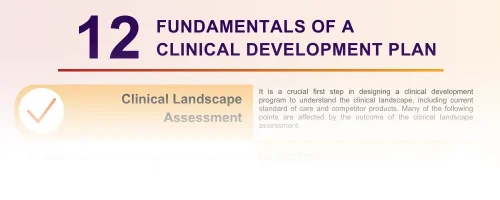Critical Importance of the Clinical Development Plan
Imagine you walk onto a plot of land and decide it is the perfect place to build your next home. You excitedly pour the foundation and begin sequentially constructing the floors of your home on top of it. By the time you reach the top floor, you are constrained by decisions and features of earlier stages of construction. In the end and without proper foresight, your final product cannot match your vision, at least not without investing substantially more time and money, due to a failure to view the construction process holistically. While we hope you aren’t reading this blog for construction advice, comparable pitfalls, which lead to budget overruns and missed timelines, can happen in a clinical development program if appropriate planning is not considered.
A clinical development plan (CDP) is a comprehensive document that presents a holistic strategy for developing an investigational product from preclinical testing through clinical trials, regulatory submissions, and marketing authorization. These plans can serve as critical roadmaps to ensure potential new therapies are safe and effective and ultimately meet the needs of the target patient population. For small and mid-sized biotech companies in particular, the CDP can serve as a principal indicator of potential success, encompassing multi-functional considerations of the key elements that impact the success of a clinical program.
Core Elements of the Clinical Development Plan
In this blog, we explore the fundamental elements of a CDP and outline effective strategies for optimizing that plan. Our aim is to provide key insights and recommendations that can benefit you in your early stages of product development.
Before we proceed with our analysis of Clinical Development Plans (CDPs) and strategies for optimization, it’s essential to delve into their core components. Let’s take a moment to dive deeper into the fundamental elements that constitute a robust CDP. We’ve compiled a detailed breakdown of these key elements into a convenient infographic.
Click image below to access full infographic.

This resource provides a comprehensive overview of the building blocks of a successful CDP, serving as a valuable reference as we navigate through the complexities of clinical development plan optimization.
Having acquainted ourselves with the core fundamentals of a CDP, let’s now turn our attention to strategies aimed at optimizing this pivotal plan to meet the specialized demands of biotech companies. By implementing these strategies, you can navigate the complexities of product development with confidence and improved effectiveness.
Strategies for Optimizing Your Clinical Development Plans
Multi-Functional Review
- It’s important to include all relevant disciplines in the internal review process, such as clinical strategy, regulatory, clinical pharmacology, biostatistics consulting, medical professionals, clinical operations, and nonclinical.
- This multi-functional approach provides end-to-end optimization of each aspect of the proposed clinical development program, saving both time and money.
- The CDP should be viewed as a “living document” subject to review and revision by experts from multiple disciplines based on emerging data from ongoing clinical studies and changes in the competitive landscape for the target patient population.
Input from Key Opinion Leaders (KOLs)/Experts
- Incorporation of KOL/expert feedback is critical for ensuring your clinical development program can be realistically carried out.
- KOLs and experts can provide real-world insights concerning the target patient population, the current standard of care for the indication, and potential challenges with protocol operationalization and recruitment for a given program. Their input may result in [re]-consideration as to where the investigative product fits in the standard of care (SOC), whether it should be developed as monotherapy or add-on to SOC, additional considerations for inclusion and exclusion criteria, centers known to treat a significant number of patients with the indication, etc.
- Consider partnering with KOLs with grant funding for an investigator-sponsored proof-of-concept study to expedite the overall development program and help generate funding for biotech-sponsored trial(s).
Refine the Target Population (utilize well-justified entry criteria)
- Overall prevalence of an indication, the mechanism of action/target of the investigative product, the competitive trial landscape, and emerging data may all necessitate refinement of the final target population throughout the development program. It is important to also consider how/where the investigative product may fit into the standard of care.
- For biomarker-defined patient populations, consider utilizing a basket study design to efficiently assess the effectiveness of the investigative product in multiple indications in one study.
- Entry criteria should appropriately reflect the risk-benefit profile of the investigative product. Most patients in early phase studies will have exhausted multiple, if not all, therapeutic options available to them but must still be healthy enough to ensure their safety. In later-phase studies, the entry criteria should reflect the expected health status of the expected patient population for the target indication.
Optimize Study Design: appropriate study design, statistical analysis plans, reduce patient burden, biomarker selection, clinical landscape/feasibility, etc.
- A CDP should identify the number of studies to meet the long-term goals and the high-level design of each study, including objectives and endpoints, intended study population, and identification of any controls (i.e., inactive placebos or active comparators). The standard of care and active competitive landscape (especially those in late stages of development) are also key elements of this analysis.
- Precedent set by approved products, relevant FDA guidances, and primary literature sources should be leveraged for power calculations for proposed efficacy endpoints and to identify appropriate biomarkers to evaluate throughout the study. Some biomarkers may be considered as surrogate endpoints if representative of a clinically meaningful benefit.
- The CDP may contain some operational and decentralized considerations. This may include a clear list of assessments to be performed throughout the study and the schedule, with the goal of avoiding overburdening patients with unnecessary visits to the site for assessments and dissuading them from entering the trial or resulting in noncompliance. Decentralized clinical studies, where appropriate, can be employed to limit patient burden without compromising the integrity of trial data. Refer to the SPIRIT checklist for clinical protocol content development to ensure efficient study design and relevant assessments that match to an endpoint.
- It’s important to not overlook geography. The location of trial sites will impact multiple aspects of study design and the ability to execute. These include the length of time from initial regulatory submission to first patient in, patient availability and enrollment rates, and the prior treatments, concomitant treatments, and standards of care available for use as active comparators.
- Align the CDP with your regulatory strategy (including expedited programs)
- Incorporate regulatory milestones into the CDP and account for these activities in the overall program timeline to ensure the clinical and regulatory strategies are aligned.
- Plans for meetings with regulatory bodies after completion of each study are generally assumed. Clinical data generated from previous trials should be clearly presented within the meeting briefing package to justify the proposed design of the next clinical study.
- If developing a product to address an unmet medical need for a serious or life-threatening condition, you may qualify for one or more of the following expedited programs in the United States (there are different expedited pathways in other regions) to accelerate your overall development timelines: fast track designation, breakthrough therapy designation, regenerative medicine advanced therapy designation, accelerated approval, and/or priority review designation. A well-written CDP can provide insight into when certain expedited pathways could reasonably be sought within a development program. Surrogate endpoints previously used as the basis of approval or licensure under accelerated [and traditional] approval processes can be found here: Table of Surrogate Endpoints That Were the Basis of Drug Approval or Licensure | FDA. If utilizing a surrogate endpoint for accelerated approval, your development plan will need to include a confirmatory clinical study.
Conclusion
The effort and resources involved in constructing a comprehensive CDP can be considerable. However, a multi-functional CDP provides immeasurable value in defining a roadmap for product success that defines opportunities while preparing for anticipated risks.
At Allucent, our unique combination of experts across Clinical Strategy, Medical Affairs, Biostatistics, Regulatory, Clinical Pharmacology, and Patient Engagement enables us to be an optimal partner in authoring your clinical development plan and helping to ensure the success of your product development journey.
